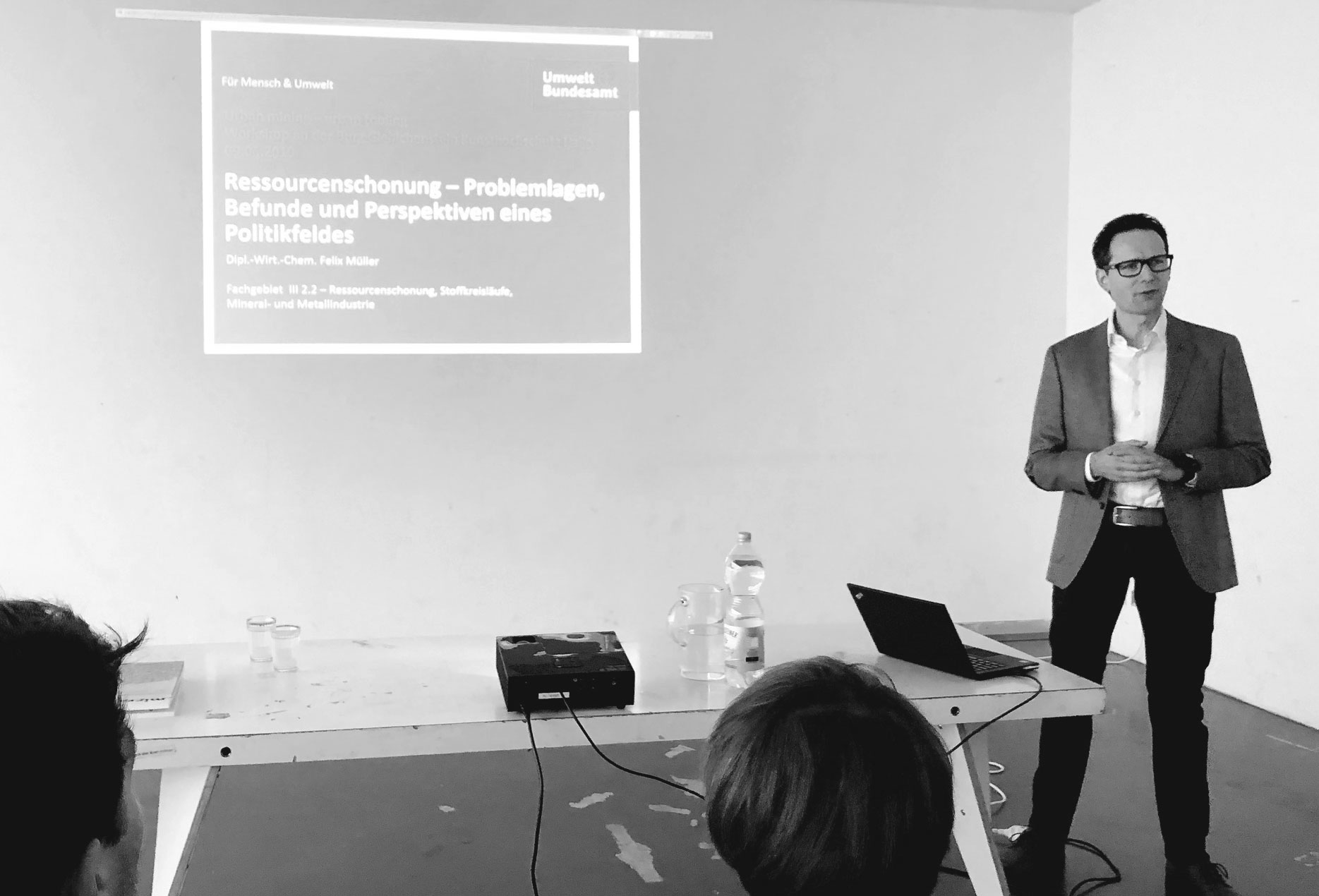URBAN MINING LECTURE by FELIX MÜLLER
Halle – 09.04.2019
Felix Müller started his lecture with: One of the biggest design flaws may possibly be the way we commute, car transportation with its roads and waste of fuel. The environmental impact of looking at the automobile industry is underestimated. Factors such as road construction, destroying valuable biotopes in addition to the resources used and the consumption of energy are not considered in the life cycle assessment of a vehicle.
This is one of the reasons why we are now in what we might call the Anthropocene age, where earth’s cycles and systems are above all influenced by mankind. Due to the immense intervention of humans in our ecosystem, there is more and more discussion about what the ecological limits are that we have to comply with but also have already crossed. All this is summarized in the concept of ‘Planetary Bounderies’, which was proposed in 2009 under the leadership of Johan Rockström. For example, the irretrievable loss of genetic diversity by dying species is presented.
Complementary resource management strategies contribute to this. They are practiced as the outsourcing of production and raw material extraction abroad. On first glance, this saves costs and improves the CO2 balance. Pollution of groundwater and air, as well as the poisoning of the population is shifted to the mining countries. This action and the transfer and outsourcing of responsibility is often described as ‘NIMBY – Not in my Backyard’ attitude.
‘The wrong thing becomes perfect and therefore perfectly wrong.’ (M. Braungart) Many companies dependent on special raw materials, for which a variety of supply risks are already emerging today. These are referred to as critical raw materials. Substitutions at the material level through the exchange of individual materials or new factor combinations that can work with new technological concepts and functionalities create ways to dispense with critical raw materials. All types of substitutions also represent quality-substitutions.
In Germany, each inhabitant accumulated an average of 317.27 t of mineral materials in 2010. It contains valuable secondary raw material reservoirs – an anthropogenic material storage.
This storage can but should not grow as fast in the future. Ideally materials from the storage should be used again to enter the cycle as secondary materials – a main principle of Urban Mining.
Not all objects found in the material storage can actually be reused as secondary materials, as certain mistakes already happen during the design phase.
In this phase, several aspects should already be considered, such as the necessary lifetime of a product, appropriate manufacturing technologies and the recyclability and the processing of materials in a way that they can be separated again later on. In spite of often knowing better, pollutants are repeatedly incorporated into products and buildings, which in and of themselves make up only a small amount, but represent a large amount of materials that cannot be reused, one example being asbestos. Not all materials are equally worth recycling. The question whether the ecological expenditure justifies a certain benefit must always be asked. With metals like aluminium, recycling 90% of the material is worthwhile, the rest of it is too small to justify the extra energy expenditure.
A Life Cycle Assessment (LCA) can and should be drawn up for all products. This is an analysis of the environmental impacts of a product, processes or services throughout their entire life cycle. This is used to develop and improve products, as a variety of environmental impacts that are not immediately related to each other. One example could be the negative impact a product can have on health, or problematics related to material availability. One point of discussion when drawing up the life cycle assessment is the relationship between those aspects involved.
When life cycle assessments are drawn up, there is often an aggregation dilemma. Which describes the problem that developments in different areas go into different directions, which then again are summarized in a uniform value. In some cases representative sets of indicators can be found if the same material system is used.
This is also reflected in the costs of products that are manufactured more efficiently with less use of resources. Often these are purchased more frequently because the products are more favorable to alternative offers. These are so called ‘Rebound Effects’ because the original savings are annulled by this behavior. The question to be asked is therefore not only how can the existing product be improved, but also how can a completely different business model be developed in which consumers do not have the feeling of having to give up another thing.
It is important to give notice to using materials from the anthropogenic material storage. Raw material resources are not yet so scarce that recycling is clearly worthwhile in terms of price compared to raw material extraction. New resources can still substitute lost ones. However, it is important to use existing materials and conserve resources not only because of scarcity, but also because of pollutants, energy consumption and destruction of land that occurs during the extraction of raw materials.
Often, instead of mining deposits with high ore contents, other mines with low ore contents that have already been developed are used. For example, this could be copper mines with only 3% ore content. This behaviour prevails because it is easier mining left over ores rather than developing a new cost-intensive mine and taking a long time to be profitable.

Great thanks to Felix Müller from the German Environment Agency
text: Leonhard Burmester, Viola Nauck, Sandro Wiegand
